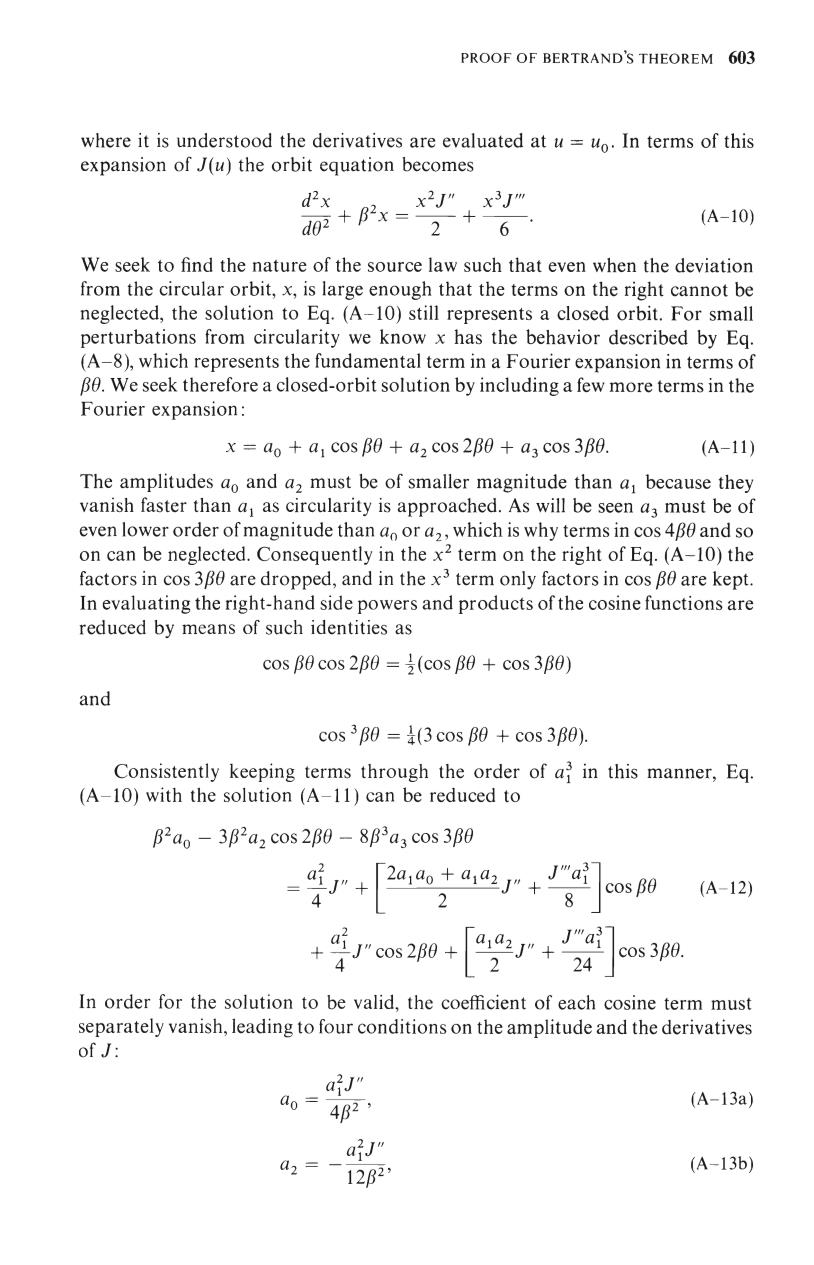正在加载图片...

PROOF OF BERTRAND'S THEOREM 603 where it is understood the derivatives are evaluated at u =uo.In terms of this expansion of J(u)the orbit equation becomes 0+Bx=Jxm d2x 2+6 (A-10) We seek to find the nature of the source law such that even when the deviation from the circular orbit,x,is large enough that the terms on the right cannot be neglected,the solution to Eq.(A-10)still represents a closed orbit.For small perturbations from circularity we know x has the behavior described by Eq. (A-8),which represents the fundamental term in a Fourier expansion in terms of B0.We seek therefore a closed-orbit solution by including a few more terms in the Fourier expansion: x=a0+a1cosβ0+a2cos2β0+a3cos3β0. (A-11) The amplitudes ao and az must be of smaller magnitude than a because they vanish faster than a,as circularity is approached.As will be seen a3 must be of even lower order of magnitude than ao or a2,which is why terms in cos 480 and so on can be neglected.Consequently in the x2term on the right of Eq.(A-10)the factors in cos 380 are dropped,and in the x3 term only factors in cos B0 are kept. In evaluating the right-hand side powers and products of the cosine functions are reduced by means of such identities as cos B0 cos 2B0 =(cos B0 cos 3B0) and cos3B0 =(3 cos B0 cos 3B0). Consistently keeping terms through the order of a in this manner,Eq. (A-10)with the solution (A-11)can be reduced to B2ao-3B2a2 cos 280-8B3a3 cos 380 +[2a,oa2J”+ J"a cos B0 (A-12) 41 8 cos3β0. 2 24 In order for the solution to be valid,the coefficient of each cosine term must separately vanish,leading to four conditions on the amplitude and the derivatives of J: aiy a0= 4B2, (A-13a) aJ" a2=- 12B2 (A-13b)PROOF OF BERTRAND'S THEOREM 603 where it is understood the derivatives are evaluated at u = u,. In terms of this expansion of J(u) the orbit equation becomes We seek to find the nature of the source law such that even when the deviation from the circular orbit, x, is large enough that the terms on the right cannot be neglected, the solution to Eq. (A-10) still represents a closed orbit. For small perturbations from circularity we know x has the behavior described by Eq. (A-8), which represents the fundamental term in a Fourier expansion in terms of PO. We seek therefore a closed-orbit solution by including a few more terms in the Fourier expansion : x = a, + a, cos PO + a, cos 2PO + a, cos 3P8. (A-1 1) The amplitudes a, and a, must be of smaller magnitude than a, because they vanish faster than a, as circularity is approached. As will be seen a, must be of even lower order of magnitude than a, or a,, which is why terms in cos 4PO and so on can be neglected. Consequently in the x2 term on the right of Eq. (A-10) the factors in cos 3p6' are dropped, and in the x3 term only factors in cos PO are kept. In evaluating the right-hand side powers and products of the cosine functions are reduced by means of such identities as and cos 3p0 = i(3 cos PO + cos 380). Consistently keeping terms through the order of a: in this manner, Eq. (A-10) with the solution (A-11) can be reduced to P2ao - 3p2a2 cos 2/38 - 8P3a3 cos 3pe =-J"+ a: 4 cos (A-12) a: + -J"cos~PO + 24 I cos 3pO. 4 In order for the solution to be valid, the coefficient of each cosine term must separately vanish, leading to four conditions on the amplitude and the derivatives of J: (A- 13a) (A- 13b)